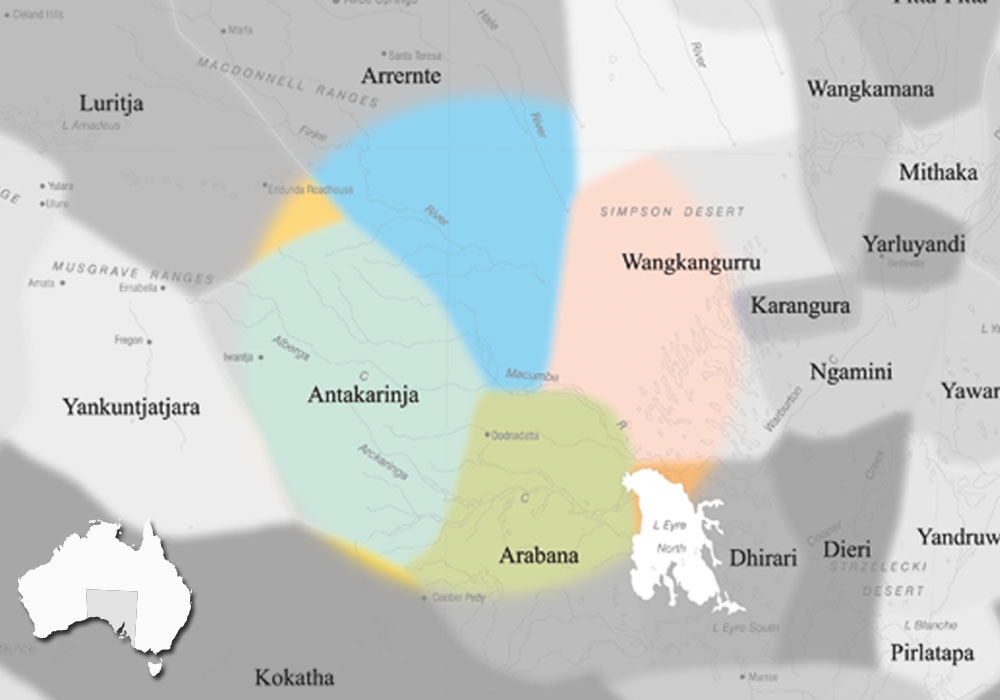Lower Arrernte is a language traditionally associated with the area surrounding the lower Lhere Pirnte (Finke River, southern NT) and Uringke (Macumba River, northern SA). Lower Arrernte is part of the Arandic language family, and has sometimes been referred to as Arrernte Imarnte, which means ‘solid Arrernte’ in the language. Structurally, the language is quite different from its other Arandic neighbours. Neighbouring languages include Arabana, Wangkangurru and Western Desert languages, and other Arandic languages to the north and north-west, including Pertame or Southern Arrernte. Some people consider a language called Lower Southern Arrernte to be a subgroup of Lower Arrernte, centred to the south of Lower Arrernte territory around modern day Macumba Station (SA).
Lower Arrernte peoples were heavily impacted by colonial endeavours. Expeditions through Lower Arrernte country by John McDouall Stuart in the early 1860s paved the way for the construction and maintenance of major infrastructure including the Overland Telegraph Line in 1872 and the Great Northern Railway in 1891. By the late 1930s, pastoralism was having a heavy impact on Lower Arrernte life, with most of Lower Arrernte country being controlled by the Kidman Pastoral Company. When the ‘Ghan’ train line was finally closed in 1980, European presence in the area greatly decreased. However despite encouragement for Indigenous peoples to also abandon the area, strong Indigenous populations, including Lower Arrernte peoples, continue to persist on country, particularly in the townships of Oodnadatta and Apatula (Finke). For these reasons and more, Lower Arrernte is a highly endangered language variety.
Language lessons developed by the Lower Arrernte community are available on our Online Language Learning Portal.
Lower Arrernte was first recorded by F.J Gillen in his 1875 diary. Spencer and Gillen also took audio recordings in the early 1900s, and some of these are available to listen to here.
Other short historical wordlists exist, listed here, with links where possible.
In the 1960s, linguist Ken Hale recorded two hours of Lower Arrernte language with speaker Tom Bagot.
Linguist Luise Hercus recorded various Lower Arrernte speakers as part of her documentation of the neighbouring Wangkangurru language.
More recently Gavan Breen has worked with speakers of Lower Arrernte in the nineties and 2002. Breen has produced a small draft dictionary for the language based on his own recordings and previous work on the language.
The MLT has been undertaking ongoing language work with Lower Arrernte peoples in Oodnadatta since 2016, and has supported the creation of various audio-visual linguistic resources, along with a Lower Arrernte language display at the Oodnadatta Railway Museum. The MLT has also supported linguistic fieldwork by Celeste Humphris in Oodnadatta in 2016. Humphris has subsequently produced an Honours dissertation (2017) entitled A Morpho-Syntactic Sketch of Lower Arrernte, Central Australia, drawing upon historical and modern language data.
There are no current published sources available for Lower Arrernte.
If you would like any further information about Lower Arrernte language, and the MLT’s ongoing work with the Lower Arrernte community, contact us here.
VARIATIONS
Alenyerntarrpe (uncomplimentary name given by northern dialects), Alinta, Arinta, Arrernt Imarnt [meaning ‘solid /strong Arrernte’], Arrernt Imernt, Lower Arrernte, Lower Aranda, Aranda Lower Southern.

DISCLAIMER:
The above map is based upon the Horton Indigenous Map of Australia © Aboriginal Studies Press, AIATSIS, and Auslig/Sinclair, Knight, Merz, 1996. The full map is available on the AIATSIS website. The locations of the languages of SA, as stated on the this website are not intended for Land Claim use, and are an approximate guide only. Individual language project locations are based on information from publicly available MILR (ILS) documents.
